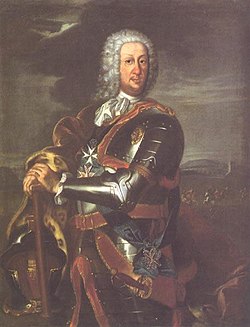
Boris Sheremetev
Count Boris Petrovich Sheremetev | |
|---|---|
 Portrait by P. Krasovskiy | |
| Born | 5 May 1652 Moscow, Tsardom of Russia |
| Died | 28 February 1719 (aged 66) Moscow, Tsardom of Russia |
| Allegiance | |
| Service | Imperial Russian Army |
| Years of service | 1681–1719 |
| Rank | Field Marshal |
| Battles / wars | Russo-Polish War |
| Awards | Titles: Boyar (1686) Count (1706) Orders: Order of St. Andrew Order of the White Eagle Order of the Black Eagle |
Count Boris Petrovich Sheremetev (Russian: Граф Бори́с Петро́вич Шереме́тев, tr. Borís Petróvič Šeremétev; 5 May [O.S. 25 April] 1652 – 28 February [O.S. 17 February] 1719) was an Imperial Russian diplomat and general field marshal during the Great Northern War. He became the first Russian count in 1706. His children included Pyotr Sheremetev and Natalia Sheremeteva.

Early life
In his youth, Sheremetyev was a page to Tsar Alexis I before starting his military career. From 1671 he served at the imperial court. In 1681 he was a leader at Tambov, commanding the armies fighting the Crimean Khanate, and from 1682 he was a boyar. From 1685 to 1687 he participated in negotiations and the conclusion of the "Eternal Peace of 1686" with Poland and the allied treaty with Austria. From the end of 1687 he commanded the armies in Belgorod defending Russia's southern border, and participated in the Crimean campaigns. After Peter I gained power in 1689, he joined him as a fellow campaigner. He participated along with Mazepa in the war against Turkey during the 1690s. During the Azov campaigns in 1695–96 he commanded armies on the Dnieper River in actions against the Crimean Tatars. In 1697–99 he carried out diplomatic assignments in Poland, Austria, Italy and Malta. In 1698, czar Peter sent a delegation to Malta under Sheremetyev to observe the training and abilities of the Knights of Malta and their fleet. Sheremetyev also investigated the possibility of future joint ventures with the Knights, including action against the Turks and the possibility of a future Russian naval base.[1]

Great Northern War

During the Great Northern War (1700–1721) Sheremetev proved a capable but cautious and sluggish military leader. For much of the war he served as the commander-in-chief and most senior officer in the Russian army. Sheremetev was very cautious in his movements but proved more effective than the younger Prince Menshikov, the second-in-command, whose impulsiveness did not always lead to success.

In 1700 he joined the Russian army in its attack on Narva at the outbreak of the Great Northern War, but King Charles XII of Sweden drove him back from his position in Estonia. He then became commander of the Russian forces fighting the Swedish armies in the Baltic provinces. Colonel W. A. Schlippenbach defeated Sheremetev at Rauge in September 1701, but the Russians turned the tables on Schlippenbach (now a Major-General) at Erastfer in December 1701. This victory won Sheremetev the title of field marshal, and another Russian victory ensued at the battle of Hummelshof in July 1702.[2] Sheremetev's army's attack on Marienburg (August 1702) led to Martha Skavronskaya coming to the tsar's court, where she eventually became Empress Catherine I[3] (reigned 1725–1727).

Sheremetev took the Swedish Ingrian fortresses of Nöteborg (October 1702) and Nyenskans (1 May 1703) (allowing the foundation of the city of Saint Petersburg later in May 1703)) and the important Baltic cities Dorpat and Narva in 1704. In 1705 Peter I sent him to Astrakhan, where he forcefully and successfully repressed the Astrakhan uprising [ru] of 1705–1706.[4]

In the course of the Great Northern War, Sheremetev clashed with the Swedish general Lewenhaupt, who beat him at Gemäuerthof in July 1705, and Charles XII, who defeated him at Holowczyn (July 1708). Sheremetev's revenge came at the Battle of Poltava in 1709, where he functioned as the senior Russian commander of the forces which soundly defeated the Swedish army. Armies under his command conquered Riga in 1710. Sheremetev then led the main forces of the army against the Ottomans in the Prut campaign of 1710–1711. Fighting against Turkey in 1711, he suffered encirclement at the Battle of Stănileşti on the Prut (July 1711). In 1715–17 Sheremetev commanded armies in Pomerania and in Mecklenburg.


Although sympathetic to Peter I's policy of Westernising Russia, Sheremetev never became close to the tsar. He died in 1719 in Moscow; Peter I had him buried in the Lazarevskoe Cemetery in St. Petersburg.

References
- ^ "Russian Grand Priory - Time Line". Archived from the original on 2008-02-08. Retrieved 2008-02-09.
- ^ Polovtsov 1911.
- ^ Hughes 2004, p. 131.
- ^ Novitsky et al. 1911.
Sources
- Hughes, Lindsey (2004). "Catherine I of Russia, Consort to Peter the Great". In Campbell Orr, Clarissa (ed.). Queenship in Europe 1660-1815: The Role of the Consort. Cambridge University Press. pp. 131–154. ISBN 0-521-81422-7.
- Polovtsov, Alexander (1911). Russian Biographical Dictionary. Vol. XXIII: Шебанов—Шютц. St. Petersburg: Типография Главного Управления Уделов. pp. 114–115.
- Novitsky, Vasily F.; Schwartz, Aleksey V. von; Apushkin, Vladimir A.; Schoultz, Gustav K. von (1911). Военная энциклопедия Сытина [Sytin Military Encyclopedia] (in Russian). Vol. III. Аральская флотилия – Афонское сражение. Moscow: Типография Т-ва И. Д. Сытина. p. 194. Retrieved 16 September 2023.
- 1652 births
- 1719 deaths
- Field marshals of Russia
- Counts
- Nobility from the Tsardom of Russia
- Knights of Malta
- Sheremetev family
- Russian military personnel of the Great Northern War
- 17th-century Russian military personnel
- 18th-century military personnel
- Burials at Lazarevskoe Cemetery (Saint Petersburg)
- Recipients of the Order of the White Eagle (Poland)
See what we do next...
OR
By submitting your email or phone number, you're giving mschf permission to send you email and/or recurring marketing texts. Data rates may apply. Text stop to cancel, help for help.
Success: You're subscribed now !
